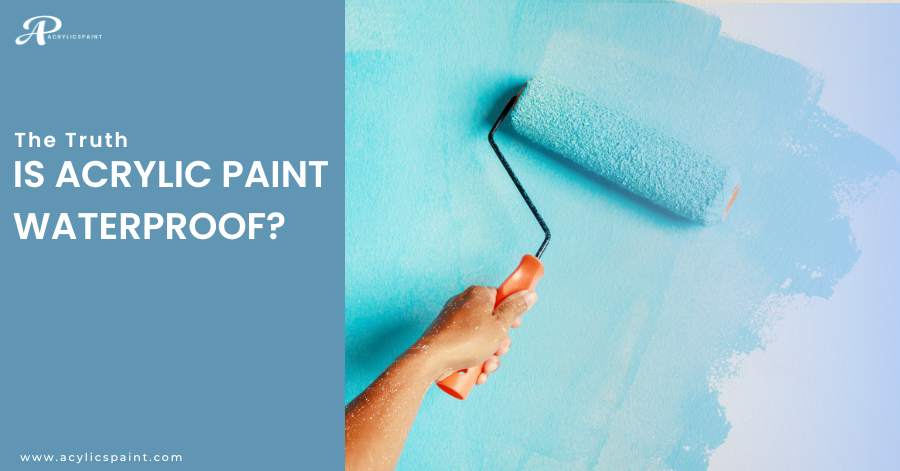Is Acrylic Paint Waterproof? The answer to whether acrylic paint is waterproof depends on several factors. When acrylic paint dries, it forms a water-resistant layer but may not be entirely waterproof. Paint can resist water to some degree, but if it’s exposed to water for too long or too much, it can start to break down or get damaged.
Let’s take a closer look and find out if acrylic paints are waterproof
Are acrylic paints waterproof when dry?
Acrylic paints exhibit a degree of water resistance once they dry, but they are not entirely waterproof. Acrylic polymer emulsion in the paint forms a durable film upon drying. However, too much water or moisture can still harm it, so it’s best to let it dry completely to avoid any damage. To ensure longevity and enhance their waterproofing, paintings should be safeguarded with additional sealants or varnishes.
Exploring the Myths: Is Acrylic Paint Waterproof?
Despite the widespread popularity of acrylics, misconceptions still linger regarding their waterproofing properties. Let’s address some common myths and explore effective methods for waterproofing acrylic paint.
Myth 1: Acrylic Paint is Completely Waterproof
The question may arise, “Are acrylic paints waterproof when dry?” The simple answer is that acrylic colours have water resistance when dry but are not impervious to moisture. Leaving acrylic paint in water for a long time, especially outdoors or in humid places, can weaken it. This can damage the artwork, so keeping it safe from these conditions is essential to ensure it lasts.
This is why additional waterproofing measures are often necessary to protect artwork from damage.
Myth 2: All Acrylic Paints Have the Same Waterproofing
Not every acrylic paint offers the same level of water resistance. Some acrylics resist water better than others because of differences in pigment strength, binder quality, and added ingredients. It’s important to pick high-quality paints made to last, particularly if you plan to showcase your art outside or in damp locations.
Myth 3: Dry Acrylic Paint Can’t Be Waterproofed
Despite what many people think, there are plenty of ways to make acrylic paint more waterproof after it dries. Artists can use sealants or unique waterproofing products to protect their acrylic artworks from water harm.
Acrylic Waterproofing Paint
Artists can use acrylic paint or sealers to enhance the waterproofing capabilities of acrylics. These products are designed to provide an extra layer of protection, making paintings more resistant to moisture and the environment. Acrylic waterproofing paints come in various formulations, including sprays, brush-on sealers, and mediums that can be mixed directly with paint.
How to Waterproof Acrylic Paint
If you want to make your acrylic paintings more waterproof, there are several techniques you can try:
- Apply a Sealant: After your acrylic painting has dried completely, apply a layer of sealant or varnish. This will help protect the surface from moisture and UV damage while enhancing the colours and depth of your artwork.
- Use Waterproofing Mediums: Mix waterproofing mediums or additives directly into your acrylic paint before applying it to your surface. These additives can improve the durability and water resistance of the paint film, ensuring your artwork remains vibrant and protected.
- Layering Techniques: Employing layering techniques can also contribute to the waterproofing of your paintings. Apply multiple thin layers of paint, allowing each layer to dry completely before adding the next. This builds up a firmer, more resilient surface that is better equipped to withstand moisture.
- Protective Coatings: Consider framing your paintings behind glass or acrylic sheets to provide an additional barrier against moisture and environmental elements. This is especially important for artworks displayed in high-humidity environments or outdoor settings.
Waterproof acrylic paint sealer
A waterproofing acrylic paint sealer is a specialized product that provides additional painting protection. This sealant forms a clear, durable coating over the artwork’s surface, effectively shielding it from moisture, dust, UV rays, and other environmental factors.
Acrylic paint sealers come in different types, like sprays, brushes, and pour-ons, giving artists options. This variety allows artists to select the most suitable method for their needs and preferences. By applying a waterproof acrylic paint sealer, artists can effectively prolong the lifespan of their paintings, safeguarding them against moisture, dust, and other environmental factors.
Additionally, these sealers help enhance the vibrancy of colours, ensuring that artwork remains visually captivating for years to come. Ultimately, adding a waterproof acrylic paint sealer into the artistic process preserves the artwork and provides peace of mind for artists seeking long-term durability and quality.
Choosing the Right Acrylic Paint Sealer
When selecting a waterproof acrylic paint sealer, consider the following factors:
- Look for sealers specifically formulated for acrylics. These sealers are designed to bond effectively with acrylic surfaces, providing long-lasting protection without yellowing or cracking.
- Decide whether you prefer a glossy, satin, or matte finish for your artwork. Each finish offers different aesthetic qualities, so choose one that complements your artistic vision.
- Acrylic paint sealers are available in various forms, including spray-on sealers, brush-on sealers, and pour-on sealers. Choose an application method that suits your painting style and preferences.
- If you plan to display your artwork outdoors or in high-humidity environments, opt for a sealer with enhanced waterproofing and UV protection.
Application Tips for Waterproof Acrylic Paint Sealers
- Before applying the sealer, ensure your painting is clean, dry, and free from dust or debris.
- Use a brush or spray applicator to apply the sealer in thin, even coats. Avoid applying too much sealer at once, resulting in drips or streaks.
- Allow each coat of sealer to dry completely before applying additional coats. This helps ensure proper adhesion and a smooth finish.
- Always follow the instructions for application, drying times, and recommended number of coats to achieve the best results.
Conclusion
You can find the accurate answer to your question, “Is acrylic paint waterproof?“. We know that acrylics are inherently water-resistant but may not be entirely waterproof. With the application of acrylic waterproofing paints and sealers, along with the implementation of appropriate techniques, artists can boost the waterproofing abilities of their paintings. Understanding how to make acrylic paint waterproof is vital for preserving artwork. Whether painting on canvas or decorating outdoors, knowing these methods helps protect your creations from damage over time.














